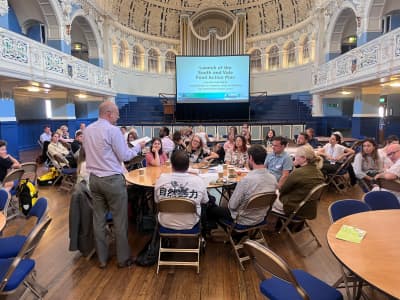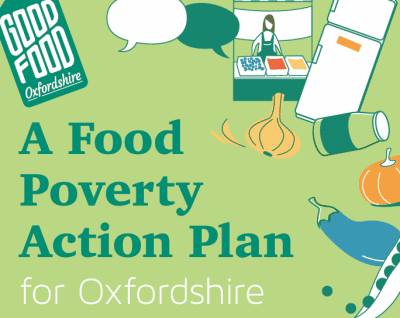This opinion piece is a guest post by GFO network member Chloe Horner who runs her own local food enterprise What Chloe Cooked Next. Apart from being a freelance cook and running a supper club, Chloe is a Mum who is passionate about healthy school food.
What is the future for school food?
My name is Chloe, I’m a cook and a mother based in Oxfordshire. My eldest daughter Violet qualifies for free school lunches and during the first lockdown we carried on receiving them. I was alarmed about the sheer volume of sugar and refined carbohydrates they contained so I spoke to my school.
I was also in a job application process at the time which required me to present on an area of food I was passionate about, so I chose ‘Food in Schools’. I spoke to teachers and business managers at several Oxfordshire and Berkshire schools as well as doing some broader research into food education and food in schools.
I am so thrilled that the situation with school dinners is finally receiving a good deal of media attention. Whilst the images of food boxes supplied to families schooling at home circulating in the media were shocking (and woefully inadequate), it’s easy to lose sight of the bigger picture and see that this is part of a far larger problem around school food.
Where do things stand right now?
I wrote to my child’s school who were helpful with the information they gave, but essentially I realised that the problem with school food is that it is often out of the hands of anyone working hands-on with children – the head teachers, parents, teachers, cooks and even school governors.
All children from Reception age to the end of Year 2 can have free school meals regardless of their financial situation. After that, more free meals can be claimed depending on circumstances. For simplicity’s sake, a child receiving school meals until Year 2 will eat approximately 600 meals – a fair proportion of their food intake during that time. Schools are paid £2.30 per child/meal for each free school meal, which includes the costs of paying kitchen staff.
The system of feeding children at school in this country is broken. And here’s my opinion why:
- School food policy has failed to sustain quality nutrition. This includes structural issues, inadequate funding and lack of autonomy to manage school budgets.
- Poor consistency of evaluation around food in schools.
- Low uptake of school meals means the economy of scale doesn’t work in some schools, making outsourcing a necessity, not a choice.
- Children are ALWAYS given two choices of meal. This weighs more heavily on cooks’ time and skill set, meaning that they lean to more convenient but less nutritious options.
- The social element of eating has been forgotten.

More background info can be found on the Children’s Food Campaign website, a Sustain campaign championing children's rights, parent power and government action to improve the food environment children grow up in.
What about the past?
This research got me thinking about my own experiences of school food, and perhaps you could think about yours, too? Perhaps it’s jam sponge and windolene-like pink sauce, or spam fritters, maybe Jamie Oliver dressed up as a pea?! I appreciate that there is no uniformity here, but school dinner experience was thankfully very positive (and perhaps more typical of my era of schooling in the ‘80s and ‘90s).
In primary school, two local women cooked all of our lunches (mostly from scratch), we sat on large, mixed age tables with teachers and there was a limited choice (a cheese or ham ploughman’s was on offer if you didn’t fancy the main event). Not all of it was delicious but there were usually 2-3 vegetables on the plate with the choice of added pickled beetroot or coleslaw. Once in Year 6, the last at primary, we were given a range of jobs which served the greater good of the school. One of the school jobs was to go into the kitchen, write the menu and go round each class to read it out before lunch.
Why go into so much detail here? If we look at the core values and functions of school food from this era, we can find a great deal of solutions around school food and food education. Our pandemic situation could also afford school food some unique opportunities, I hope.
And how could the future look?
You can teach absolutely everything from a kitchen and a garden.
Carolyn Steel, “Sitopia” The Food Programme, BBC Radio 4
If we look to my 1980s school food model the real take-homes are to think about eating, cooking and food in schools in a holistic way. This involves communal multi-generational eating, peer encouragement around food and non-processed, home-cooked simple food that children can witness being made (and can more easily be tied into the curriculum). This way of working also offers the opportunity for food to be more tailored towards faith groups, dietary requirements and likes and dislikes, therefore creating less food waste (which I was told by everyone I spoke to is a massive issue in schools). Less choice in food allows more time for the kitchen to function well, producing higher-quality food and better cooks. Many that I spoke to suggested offering a jacket potato and salad bar would be a simple way round this. My reading of the menu at school also points to making food, cooking and eating a more integral part of the school day and school life.
Some good news is that there are simple nutritional wins that can be achieved (even given the current system and budgets). These include (but are not limited to): Using real, wholemeal breads to make nutrients more bioavailable. Using brown rice as well as bean-based pastas. Ensuring all dairy is full fat. Aiming to achieve 5-a-day with the school food. Using higher welfare meat (even if it means having meat on the menu less often). Taking pudding off the menu everyday – fruit and plain natural yogurt with nuts and seeds would be a better option; and an added bonus would be freeing up time for school cooks to create better more nutritional options for the main course.
Schools that are part of trusts often have very little say in what is served as the school dinner companies are employed across the trust (not by the schools individually – so they are not always responsible). Almost all schools and trusts rely on third party caterers whose bottom line is making money, not health or education. Because of this, most schools cannot tie food to the curriculum, grow their own food or use school food as a wider education tool. Without exception, all of the people in schools I spoke to showed a desire for food in schools to be taken back in-house.
If we were to blue-sky think about this, I would encourage the following: Every School should have somewhere to grow food, a compost bin and a kitchen. Schools should be offered every opportunity to put food at the centre of the curriculum and meals should be eaten in mixed aged groups alongside advocating adults. School meals should involve less choice, better quality food and higher-welfare meat. Healthy Eating Schools Ratings Scheme could be run alongside Ofsted and become a mark of a good, healthy school.
Some tangible opportunities right now
Hospitality’s loss during COVID-19 could be education’s gain. There is likely to be a larger pool of trained cooking staff looking for work this year. Instead of this skilled workforce being lost to other professions, let’s encourage them to work in schools.
The new National Food Strategy recommends more free school meals and higher taxes on junk food, and that can only help. A higher volume of school food being produced can only be helpful in the economy of scale of producing better school meals and making junk food more expensive could perhaps encourage a more positive move back to wholefoods.
There is a great initiative called Chefs in Schools which given the right funding could revolutionise school food. Their aim is to dramatically improve food and food standards with skilled cooks taking the helm. The Totteridge Academy in Barnet is an amazing example of what can be done – not only producing excellent quality school food but also starting an onsite farm called Grow to produce food for the school and educate pupils.

The Swan School in Oxford have pioneered vegetarian only lunch menus citing three reasons:
- Quality: Vegetarian meals allow for better quality for the same price;
- Environment: Reducing meat consumption decreases the carbon footprint of the school;
- Community: All students are able to sit together, regardless of their dietary preferences or religious requirements.
Showing that models like this can work and can be replicated in schools throughout Oxfordshire would be a great step forward.
Growing, cooking and eating food should be linked into the curriculum at every available opportunity – for instance in geography, art, maths and English – making it central to the way children learn. Another great project to investigate is Green Bronx Machine which operates across North America (but there are examples worldwide). It puts growing food at the heart of the curriculum, using classrooms to grow plants – for food, to sell and for more broader education.
Covering all of these aspirations is the Children’s Food Campaign, which calls upon all schools to sign up. Sign up to Food for Life is currently free for all schools that sign up before the Easter holidays.
I’ll leave you with this quote from Stephen Ritz from Green Bronx Machine: “It’s easier to raise healthy children than to fix broken men”. As parents and caring adults if we can find this opportunity, we should take it – and if we can’t find it, we should make it.
Resources
Healthy Eating Schools Rating Scheme
The School Food Plan
Sitopia, The Food Programme on BBC Radio 4
Chefs in Schools
Green Bronx Machine
The Totteridge Academy
What Chloe Cooked Next by Chloe Horner, author of this opinion piece



